In June 2024, about 30 Siekopai people arrived at El Estrecho, a small port on the Peruvian side of the Putumayo River. It was the third time community leaders, accompanied by elders and mothers with children, spent five days traveling far from home to present their case to a judge. They aimed to persuade the Court of the urgency of formalizing full legal title to their territory. Under the status quo, the government considers the territory “on loan” to the Siekopai Nation.
This hearing would have a decisive impact on the community’s future.
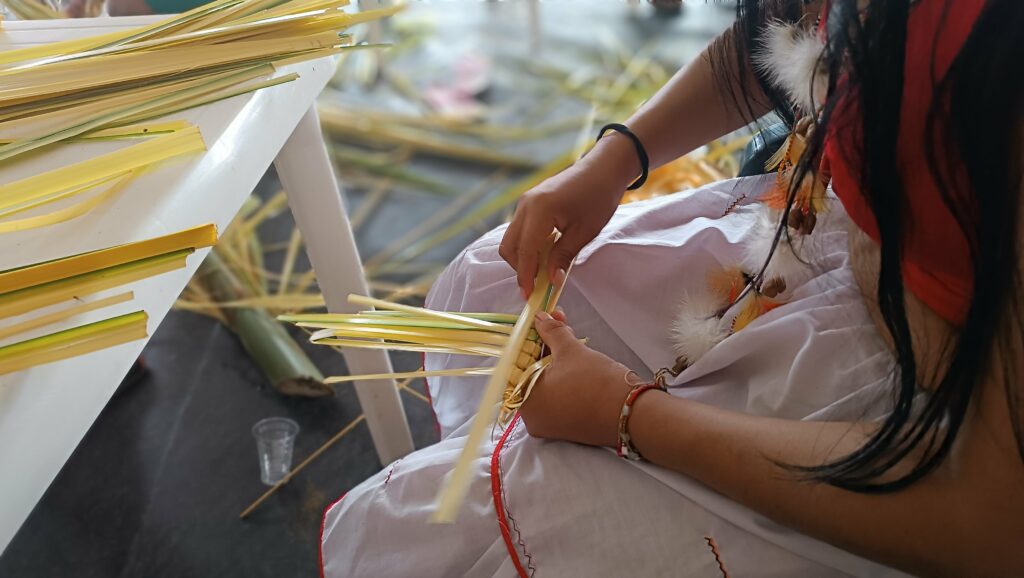
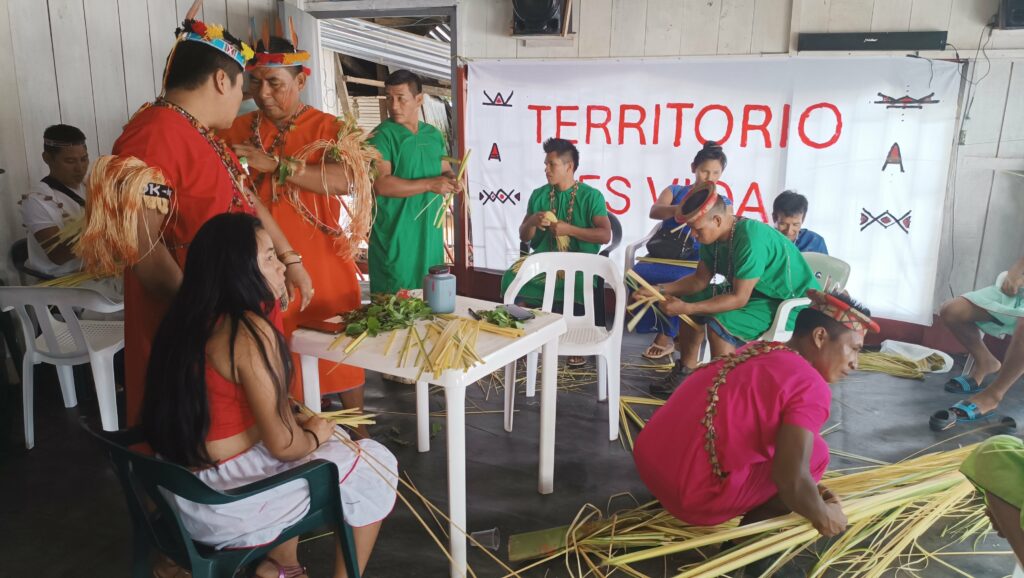
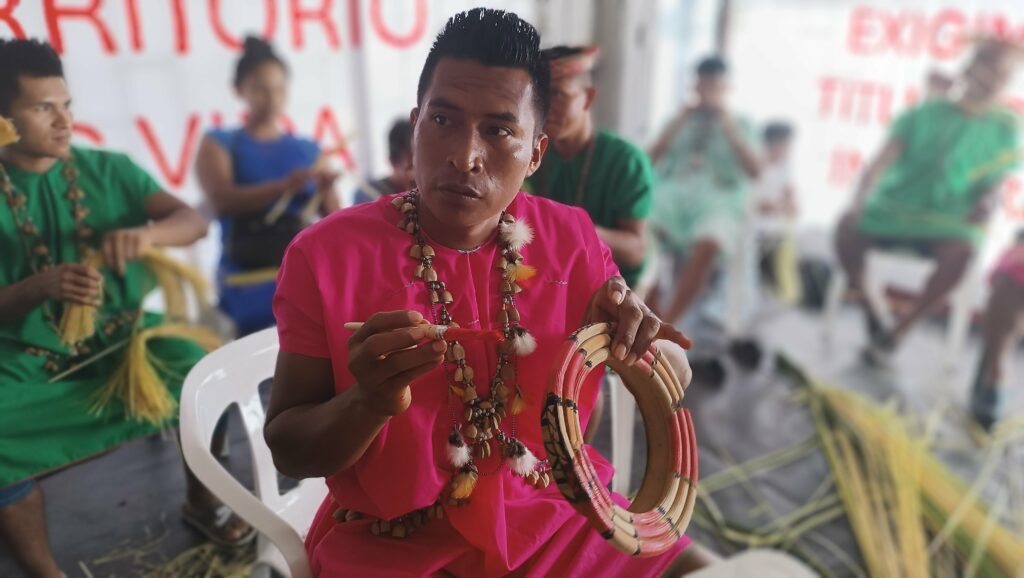
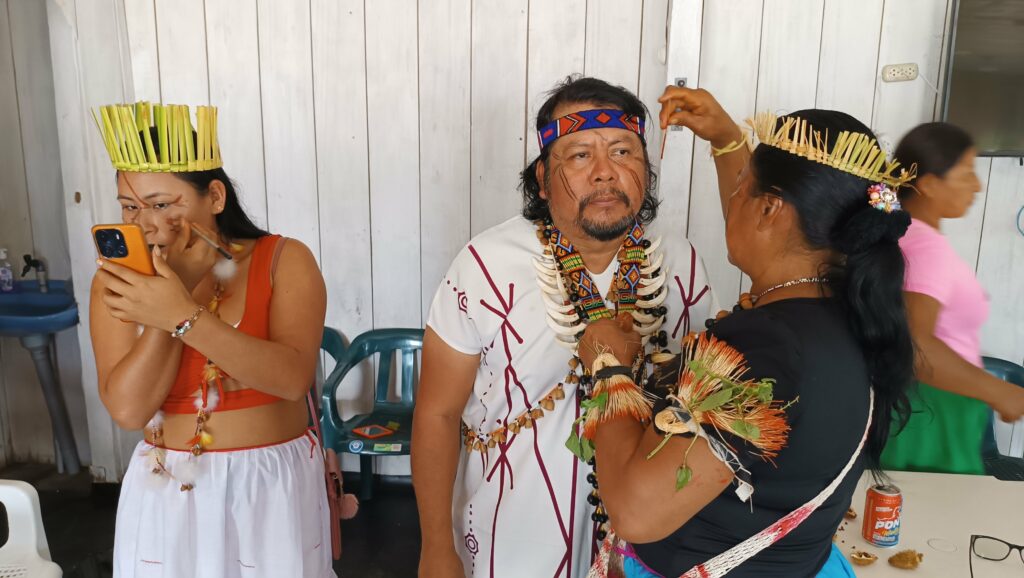
Before the hearing, in a small room, members of the Siekopai delegation pulled fibers from buds of the morete tree: long yellow and green strips which give off a subtle fragrance. Using skills passed down over centuries, women folded these strips into crowns. The elders and the young people created ma’ña (fringed bracelets) and placed them on their arms. Then, they opened achiote seed pods. They applied lines to their faces using a toothpick, black eyeliner, and a mirror to symbolize their age and readiness for battle.
Everything was ready: the colorful cushmas (a tunic made of a single piece of cloth), the seed necklaces that generated a rustling sound, the crowns, and the painted faces. They had traveled for five days and nights, and now they were prepared to undertake the task that had prompted them to come to El Estrecho.
The bustle on the main street of El Estrecho suddenly paused. Everyday life gave way to an unusual procession of women, men, and children who carried, like shields, two large banners with demands written in red: “COMPREHENSIVE LAND TITLE” and “TERRITORY IS LIFE.” They advanced slowly, circled the central park, and reached the entrance to the courthouse.
A few steps from the door, two elders from the delegation squatted down, took out a pilche (pot), and began to scrape yocó. They added water and squeezed the mixture with their hands. Through this process, the Siekopai spokespeople gained the strength to present the message of their nation during the three minutes allotted for them to speak.
Within the courtroom, a Siekopai elder from the Angusilla community in San Martín de Porres faced the judge, Diocelina Sandoval. The elder lifted her hands, holding a clay pot. She then took a breath and, in her language, spoke with confidence:
“This is an example of the work that we do as women. This pot is produced from clay collected in wetlands, on the banks of rivers, and from a special tree that grows in higher altitude areas. The shigra (woven bag) you can see is made from the fiber of a tree, and we use our yocó to braid it.”
“We have been living in and using the resources of our territory without restrictions. That is why we are asking for a comprehensive legal title.”
The Siekopai: a fragmented history
(Note: The people of the same Indigenous nation are known as Siekopai in Ecuador and Secoya in Peru. For this text, we will use the word Siekopai, whose name is in their own language, Paaikoka.)
The Siekopai have a long history in the triangular region formed by the Napo, Putumayo, and Aguarico rivers in the Amazon basin. Their records date back to 1700 when nomadic tribes moved through the forest, long before the creation of national governments or the establishment of geographical borders.
The Siekopai (Secoya) is a transborder Indigenous nation that lives in communities divided between Ecuador and Peru. They have been fragmented by evangelization and colonization, as well as a war (in 1941) that caused further displacement, increasing communal separation and dispossession. Now, communities are seeking to recover their ancestral territories to ensure the survival of their descendants and to keep their culture intact.
The Siekopai Nation has implemented various strategies to achieve its objectives. These include strengthening organizational and community resilience, mapping and monitoring territories, and undertaking legal processes for territorial recovery.
Amazon Frontlines and the Ceibo Alliance have been essential allies throughout these strategies.
How the Siekopai were decimated
“Our nation once numbered about 50,000 people (…) we used to traverse all the territory from Napo, Putumayo, Cantuta, Yubineto, Angusilla, and Tambollaco. That is where our ancestors lived,” says Anselmo Sandoval, president of the Secoya Indigenous Organization of Peru (OISPE).
With colonization brought by religious missionaries, diseases arrived that decimated the population. Then, during the rubber boom that lasted between 1820 and 1920, economic exploitation kept Indigenous people in a state of slavery. Furthermore, the war between Ecuador and Peru in 1941 caused families, communities, and territories to be torn apart. The war mainly affected the territory of Pë’këya, in the heart of Siekopai ancestral territory.
In Ecuador, the Siekopai communities are San Pablo de Katëtsiaya, Wa’iya, Bellavista, Siekoya Remolino, and Eno. They are all located within the Cuyabeno and Shushufindi cantons in the province of Sucumbíos, on the banks of the Aguarico River, and in Pë’këya.
In Peru, members of the Siekopai Nation are settled in eight communities: Bellavista (Yubineto), Mashunta, Yaricaya, Angusilla, San Belin, Santa Rita, San Martín, and Wajoya. These communities are located along the banks of the Putumayo and Napo Rivers.
In both countries, the Siekopai occupy only part of their original territory. The situation in Ecuador is critical, as they have been dispossessed of more than 95% of their territory. The Siekopai are currently one of the Indigenous nations with the smallest population. In Ecuador, there are only about 800 Siekopai people, while in Peru, the population is about 1,200 people.
Ecuador and Peru signed a Peace Treaty in 1998. After that, the Siekopai began their journey to seek justice and reparations to heal the wounds left by a conflict in which they took no side but were nonetheless victimized.
To this end, in 1999, they held the First Binational Meeting of the Siekopai Nation in the community of Wajoya in present-day Peru. Finally, brothers and sisters, cousins, grandfathers and grandmothers, and families that the war had separated could meet again. There, with the pain of years of violence weighing on them, the Siekopai began to weave together ideas and words to envision what their future could be.
Justino Piaguaje, leader of the Siekopai Nation in Ecuador, explains that talking about rebuilding families “also meant talking about the recovery of the territory; that is, re-integrating territory that has been fragmented.” Mr. Piaguaje adds, “We also thought about the issues of social, cultural, and organizational rebuilding.”
It took 24 years for a second meeting to be held in January 2023 in the community of Mañoko on the Peruvian side of the sacred territory of Pë’këya. On this occasion, in addition to the family and community reunion, the group undertook a tour of the mythical lagoons and islands that are spiritual centers for the Siekopai. The legend of Ñakomasira, which originates in this place, tells the story of an agreement between the wise elders of the community and the spirits of the water.
Recovering territory: Ecuador
For 80 years, they fought to go back. The elders dreamed of returning to the place where their placentas and the bones of their grandparents are buried; they wanted to live again with the great variety of fish in their lagoons and the abundance of nature in the forest, all of which they do not have in other communities that are eroded by oil extraction and monoculture activities.
Cesáreo Piaguaje was a Siekopai elder and healer who lived for over a hundred years; like the rest of his community, he wanted to return to his spiritual home. Don Cesáreo predicted his people’s victory in the Ecuadorian courts of justice.
In Ecuador, the territory of Pë’këya is located on the border, in a zone that the government unilaterally defined in 1979 as a protected area of the Cuyabeno Wildlife Production Reserve. The titling of this territory was the subject of a legal battle that concluded on November 24, 2023, when the Provincial Court of Sucumbíos handed down a decision ordering the Ministry of Environment, Water, and Ecological Transition of Ecuador (MAATE) to deliver the title of ownership of 42,360 hectares of the Siekopai ancestral territory.

The legal precedent is significant, although the government must still comply with the ruling. For the first time, a collective property title was obtained for an ancestral territory within a space classified by the government as a protected area. In granting this title, the court nullified the government’s arguments regarding conservation, thereby protecting the Siekopai Nation’s vast knowledge regarding the forest’s territory and care.
The victory of Pë’këya is a pillar and one of the four pilot cases of the Allpamanta Project, led by Amazon Frontlines, the Confederation of Indigenous Nations of Ecuador (CONAIE), and the Confederation of Indigenous Nations of the Ecuadorian Amazon (CONFENIAE), for the titling of Indigenous territories in protected areas. On both sides of the Peru-Ecuador border, court cases on territorial recovery are ongoing.

Recovering territory: Perú
In Peru, the struggle for full title to indigenous territories is led by three communities: Mashunta, San Martín de Porres, and Vencedor-Wajoya. In 1978, the Peruvian State gave title to a portion of ancestral territory totaling 162,000 hectares to these three Siekopai communities.
However, upon reviewing the “small print” in the documents, it became apparent that up to 80% of the titled territory was under a legal regime known as “assignment in use” (cesión en uso), meaning the land was to be used for conservation purposes, subject to conditions, revocable, and with a specific duration. In short, the territory was only on loan.
Peruvian legislation unilaterally establishes the approved use of territories and classifies them into three uses: forestry, livestock, and agriculture. The last two have been granted to Indigenous communities as property, but the areas for forestry have been given only as assignments in use.
In 2021, three Siekopai communities in Peru – Mashunta, San Martín de Porres, and Vencedor-Wajoya – joined together to sue the Peruvian government and demand the complete titling of their territory.
Edinson Cabrera Sandoval, head of territories and environment of the Secoya Indigenous Organization of Peru (OISPE), points out that if the area remains under its current designation, the communities are at risk. This is because “the owner is the Government, and it can undo the loan whenever it wants. That’s why people are demanding full ownership of the entire area.”
Lawyer Juan Carlos Ruiz Molleda of the Legal Defense Institute (IDL) in Peru, who is accompanying the communities in this process, explains that 90% to 95% of the Peruvian Amazon is considered suitable for forestry, so the assignment in use would affect around 2,500 Amazonian communities. Thus, the Siekopai lawsuit has enormous implications.
“A door is being opened that will not only require for title to be rectified and that it be granted in its entirety but will also change how regional governments, under the leadership of the Ministry of Agriculture, title the territories of indigenous Amazonian peoples,” says Ruiz Molleda.
The lawsuit also seeks the direct application of the Peruvian Constitution and international treaties signed by the Peruvian state. These include ILO Convention 169, which establishes the right of Indigenous peoples to possess all territories based on their traditional occupation and use. Under this interpretation, the Forestry Law, which provides for land classification, is not applicable.
Documenting the past
With technical and technological support from Amazon Frontlines and the knowledge of community elders as a guide, thousands of location points have been georeferenced and classified into at least 50 categories, such as maloca community structures, settlements, previously occupied communities, and others.
The uses of Siekopai territory, the routes for traversing it, and the places where ceremonies are held have also been documented. In Vencedor-Wajoya, community mapping of Siekopai sacred sites was carried out.
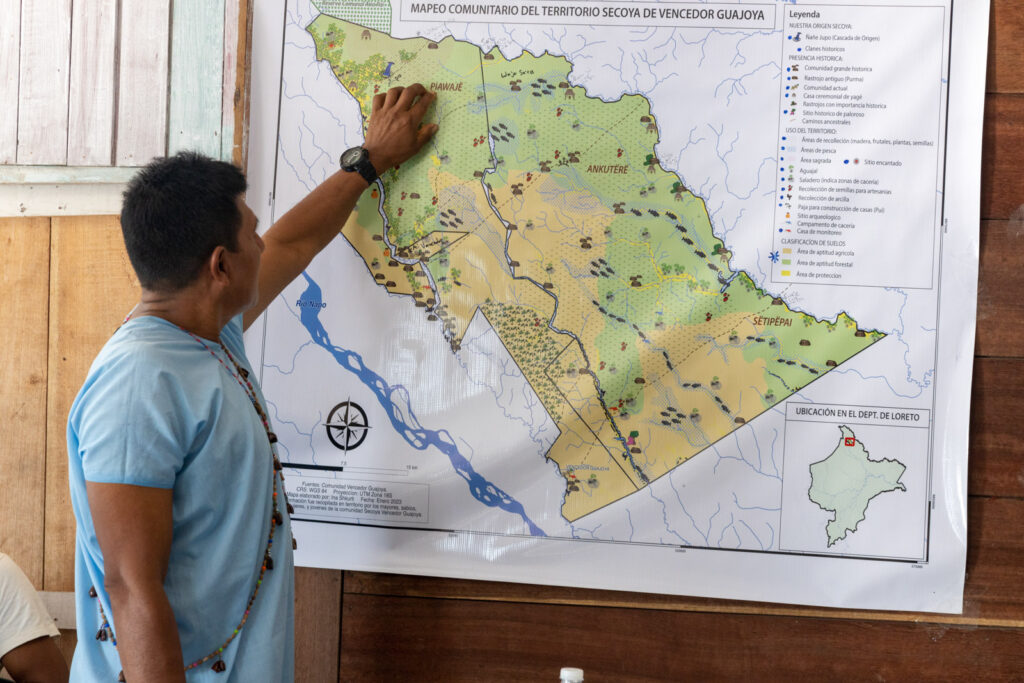
Gilberto Vásquez, president of the Vencedor-Wajoya community, presented the results of years of collected data to the judge. These include a detailed mapping of pathways, seasonal locations of fish and the people’s relationship with them, and places where Yagé is consumed. One place that is not marked on the maps remains secret; the elders say that this place, the Ñañe Jupo waterfall, is where the Siekopai god, Ñañe Paine, was born.
Justino Piaguaje recounts how, according to the elders’ stories, people with tails came out of the waterfall. They then removed their tails and threw them, forming different groups such as the Paiwaje, Ankutere, Setipepai, and others, all inhabiting the Siekopai territory located between the Napo, the Putumayo, and the Aguarico rivers.
The struggle of these three communities is a struggle for the future, to ensure that future generations of Siekopai people have a safe place to live. For us, says Gilberto Vázquez, it is not a question of suitability for forestry, agriculture, or livestock. “For us, it is about integrated, comprehensive territory management.”

They think we know more than we do
The vast knowledge of the Siekopai people about the forest, its animals, its medicinal plants, and the mythology anchored to the territory have been examples of the abundant richness of their past and their use of the territory. This starkly contrasts the regimes imposed by the Peruvian government that try to establish how land should be used.
Diocelina Sandoval remembers: “We know the forest, our territory, just as the mestizos know their cities. I have heard for a long time that the settlers are going to take our land from us because they believe that they know more than us.”
The relationship of the Siekopai with their territory is vital. As Edison Cabrera stated to the judge in the town of El Estrecho: “We depend on that territory. We are part of it. In the cities, people go to the market to get food and the hardware store to get supplies to build their homes. But we go to this space and know how to manage our territory.”
The commitment of Amazon Frontlines
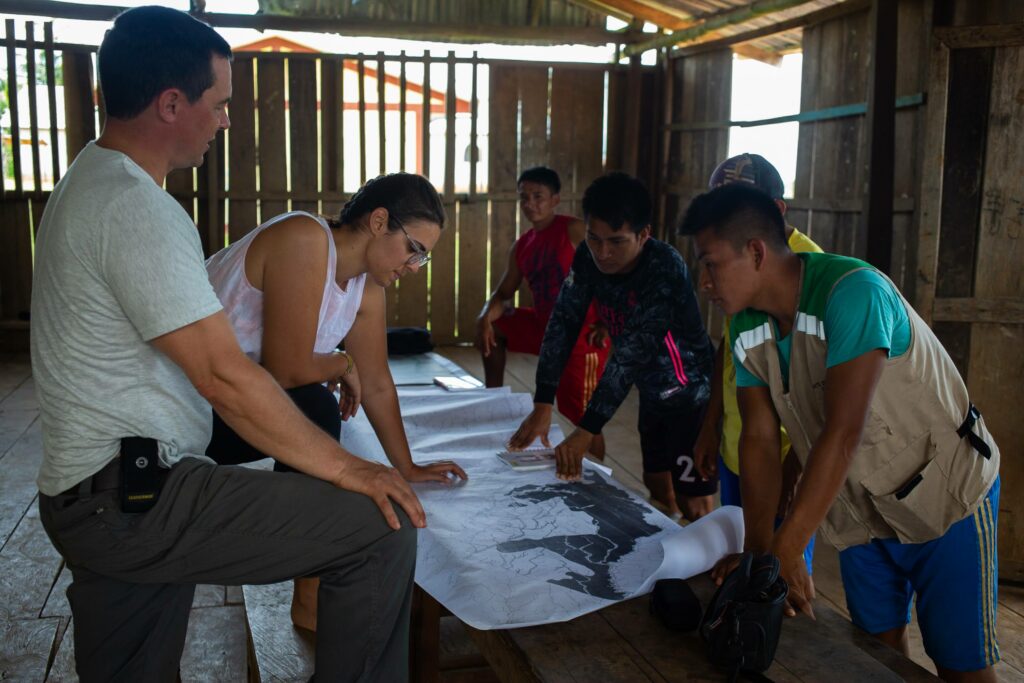
With a firm conviction that Indigenous peoples are the key to the conservation and maintenance of forests, Amazon Frontlines has accompanied the Siekopai Nation in its fight to recover its territories for the past eight years. Hand in hand with Indigenous peoples, Amazon Frontlines aims to strengthen community resilience after decades of damage from oil, mining, and agro-industrial extraction.
In Ecuador, together with our principal ally the Ceibo Alliance, we worked on the territorial mapping of Pë’këya to document sacred sites, endemic flora and fauna, and other elements of the territory. This information was presented to the Ecuadorian Ministry of the Environment in 2017. The data was crucial in the legal processes presented before the Ombudsman's Office and in the courts of justice, where the ruling ordering the granting of title was eventually handed down.
The legal process, sponsored by Amazon Frontlines, brought together various Indigenous and human rights organizations from across the country, who expressed their support through amicus briefs. These groups continue to promote alliances such as the Allpamanta project, which involves coordination with CONAIE and CONFENIAE and seeks the titling of Indigenous territories within what the government has delimited as protected areas.
Other initiatives have also emerged from this alliance, such as the Wajo'sara Indigenous Guard, developing a curriculum for autonomous education, cultural revitalization and the strengthening of women’s leadership through the Siekonomi Association. This women’s association produces ancestral foods of the Siekopai Nation, such as yuca, neapía (a black chili pepper), casabe (a crunchy yuca snack), and farinha (a type of granola also made from yuca).
Since the Siekopai is a cross-border nation, the initiatives taking place in Ecuador were extended organically to the communities in Peru. The process began in 2016 with a review of the property titles of communities unaware they did not possess full ownership rights to their territory. To deal with this problem, an alliance with the Legal Defense Institute arose, representing the communities in their case. Various amici curiae are also following the case closely.
In Ecuador and Peru, mapping and monitoring the territory have been the starting points for territorial recovery. With technical support and the use of technology, young Siekopai have traveled throughout their territory, recovering the stories of their elders and gaining a sense of ownership of their heritage. They have also learned how to use technology and become involved in the struggle.
At the same time, Amazon Frontlines is strengthening OISPE's organizational capacity to generate autonomy. According to Romero Biadaza, the expectation is “for us as young people, as Indigenous people, to be able to manage our own relationships with public and private institutions in order to improve or achieve very specific goals.” Mr. Biadaza is a young Siekopai who works in technical accounting at OISPE and is training to share this knowledge within the organization.
To improve the living conditions of the communities of the Siekopai Nation of Peru, solar panels, rainwater systems, satellite internet access, and organizational strengthening initiatives have been implemented through alliances with organizations such as the Ceibo Alliance, Rainforest, and CEFO Indigena. The partnerships continue to expand.
Amazon Frontlines is now expanding its operations to Peru through a coordination role that will generate new alliances with human rights and Indigenous organizations. The goal is to continue fighting in defense of the Amazon while centering the rights of Indigenous people.




